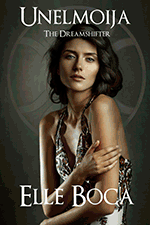by Editor | Feb 18, 2013 | Attractions, Food and Wine, New Articles
Article and photos by Josette King
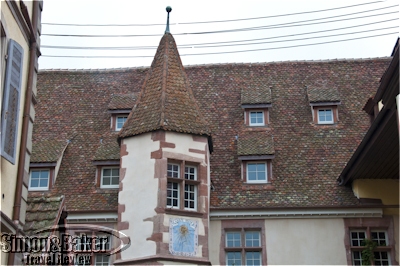
The Courtyard of the Nobles of Berckheim in Riquewihr is an early stone house and turret with sundial
In France, La Route des Vins (The Wine Road) wends its way north to south from Marlenheim (near Strasbourg) to Thann (near Mulhouse) through 170 kilometers (106 miles) of the rolling hills of the Alsatian vineyard. Along the way it reaches over half of the 119 wine-producing villages, with the remainder only a short drive away.
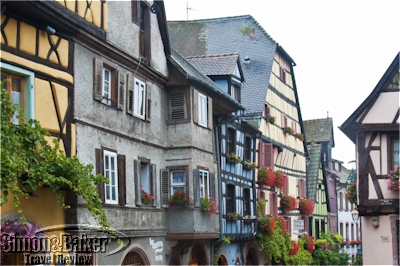
Riquewihr is recognized as one of the most beautiful villages in France for its picturesque medieval architecture
While Alsace traces its viticulture history back to Roman times and many of the villages along La Route des Vins can charm visitors with picturesque architecture reaching back to the Middle Ages, the itinerary itself is a contemporary concept. Intent on rejuvenating Alsatian tourism and refocusing attention on its once famed wine industry, both devastated by the Second World War, the regional tourism office organized an automobile rally on May 30, 1953. All participants departed at the same time, half from Marlenheim and the other half from Thann. Along the way they enjoyed a number of wine tastings and tourist site visits before reaching each other. History doesn’t seem to have recorded which team managed to travel the farthest, but the event proved to be a major success. Thus, La Route des Vins was born. Today, over two million visitors per year come from all corners of Europe and beyond to enjoy the warm welcome of the wine-growing community. Many return time and again to sample the superb wines and gastronomy of the region (paté de foie gras and choucroute garnie originated here).

Every break in the roofline offers a glimpse of the vineyards
I was recently one of these return visitors, when I was able to couple a trip to Colmar, the lovely self-appointed capital of the wine road, with a long overdue stop in the nearby village of Riquewihr. It was les vendanges (wine harvest time), and I looked forward to taking a walk up the hill beyond the city walls to the venerable Schoenenbourg Vineyards, reputed since the Middle Ages for producing some of the finest Riesling in the world, and where grapes are still picked by hand. I also planned a leisurely stroll through the historic village with its narrow cobblestone streets lined with centuries-old half-timbered houses. But most of all, I wanted to return to the Hugel & Fils winery (3, rue de la première armée, 68340 Riquewihr, France, +33 (0)3 89 47 92 15, fax +33 (0)3 89 49 00 10, http://www.hugel.com, info@hugel.com), and pay a quiet homage to the memory of a man who almost four decades ago kindled my interest for good wines. Jean Hugel had hosted my first wine tasting in the very cellar where I was now headed. Along with the basics of wine appreciation, he taught me a golden rule by which I still measure wines today.
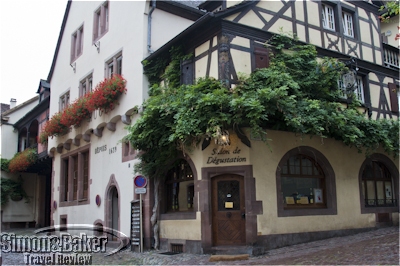
The Hugel Winery headquarters and cellars below
“A good wine,” Jean Hugel told me, “is one that you enjoy when you drink it, still appreciate when you pay for it, and can remember fondly when you wake up the next morning.” He was at the time at the head of Hugel & Fils, one of the most prestigious labels in Alsace, and a family that traces its wine making tradition back 12 generations, to 1639. I was saddened in the summer of 2009 to read his obituary in The New York Times, where he was memorialized as “a leading force in resurrecting the Alsatian wine trade.” I could only nod, and remember his passion as he introduced me to the peerless Hugel Rieslings and Gewurztraminers and most exquisite of all, the nectar-like Vendange Tardive (late harvest) wines. These prestigious wines are made in tiny quantities from overripe grapes picked well after the classic vintage, and in the best years only. These grapes have been affected by botrytis cinerea (a fungus commonly known as pourriture noble, or noble rot). Jean Hugel is credited with writing the rules for the production of Vendange Tardive, which became law in 1984. To this day, no matter where in the world I happen to be, I can never see one of the green fluted bottles with their iconic yellow Hugel label without remembering my host on that long ago afternoon.
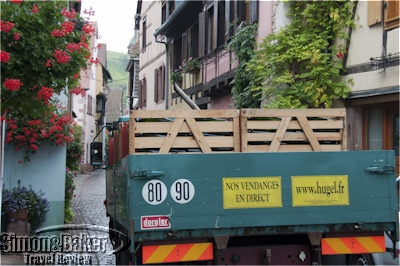
A passing wine harvest truck shows me the way to the Hugel Winery
On the day of my visit, his nephew Etienne Hugel welcomed me to Riquewihr with the same warmth and enthusiasm. Alas, the weather was not so friendly. A cold drizzle had been falling since morning; not a propitious day for a walk to the Schoenenbourg. We headed for the cellars instead, under the meticulously preserved 16th century building of the Hugel headquarters. Along the way, we stopped by the dock where trucks were pulling in with their precious cargo of plump white grapes in plastic tubs. These were immediately brought to the press house, quality tested and selected before being tipped through a funnel designed to gravity-feed them into one of the pneumatic presses on the floor below. The free-run and first pressing juices are then directed, again by gravity only, into stainless-steel vats where they settle overnight to remove solids before the fermentation process begins (Hugel uses only these for its own label. The last pressing is always set aside and sold in bulk). The juice is then gravity-fed into giant oak casks, some over 100 years old, or into stainless steel vats for fermentation.
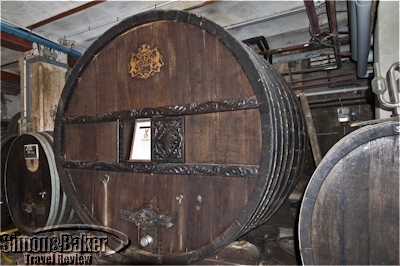
The Sainte Catherine cask dates back to 1715 and is still in use today
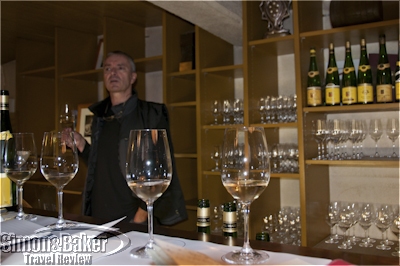
Wine tasting with Etienne Hugel
We continued on, farther into the cellar that reaches deep and wide under the old town. Wines mature there in rows upon impressive rows of huge casks, including the famous Sainte Catherine dating back to 1715, and still in use, before ending our tour in the tasting room. Etienne takes us on a seven-wine graduated tasting with the same verve as his uncle did so many years ago. By the time we get to the Gewurztraminer Jubilee 2008 and the divine Gewurztraminer Vendange Tardive 2005, both from the oldest plots of the Hugel estate in the heart of the Sporen grand cru area, I am ready to break all the rules of wine tasting: I sip, and I swallow. I am certain that Jean Hugel would approve
by Editor | Feb 4, 2013 | Accomodations, New Articles
Article and photos by Josette King
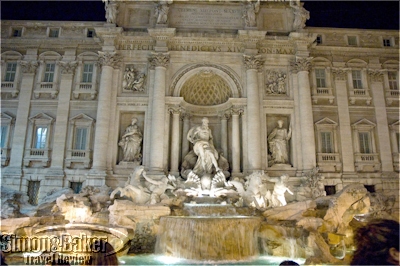
The Trevi Fountain at night
On my first visit to Rome many decades ago I threw the obligatory coin over my shoulder into the Trevi Fountain. It worked. Every few years I seem to come across a new opportunity to return, any excuse will do. Most recently, it was a fortuitous three-day stopover during an extended tour of the region. I deliberately had no agenda other than roaming around the city to soak up the atmosphere of a few favorites spots, and discover new ones along the way. Located in the center of Rome, a five-minute walk from Stazione Termini (Termini for short), the central train station, bus terminal and subway station, and within walking distance from most of the major tourist landmarks, the Hotel Mediterraneo first caught my attention as an ideal base for my explorations; and quickly intrigued me for its Art Deco origins, an architectural style I had not until now associated with the Eternal City.
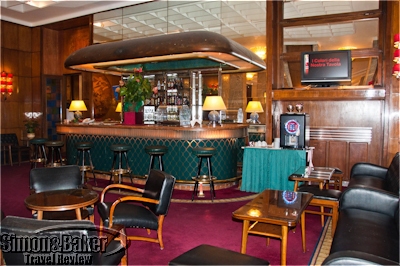
The bar at the Hotel Mediterraneo
Designed in 1936 by noted architect Mario Loreti for Maurizio Bettoja (then head of Bettoja Hotels), the property opened in 1942. To this day it remains the flagship of Bettoja Hotels, one of the oldest and largest family-owned hotel groups in Italy, now in its fifth generation. And with its original grandeur meticulously maintained by Maurizio’s successors, some consider the Mediterraneo among the finest examples of Art Deco architecture and rationalist design in Rome.
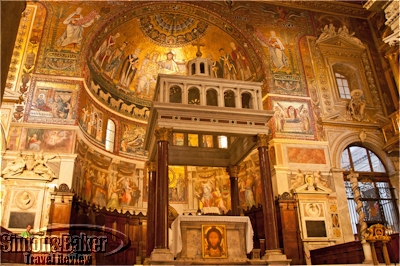
The Santa Maria Maggiore high altar
After a day of wandering through churches and palazzos filled with lavish millennia-old frescoes and extravagantly ornate carvings dripping with gold, the slick polished marble columns and exotic woods paneling of the airy and somewhat austere public spaces characteristic of the Art Deco style were a relaxing contrast. Common areas were filled with remarkable decorative elements of the era, and subtle reminders that, rationalism notwithstanding, eternal Rome endured.
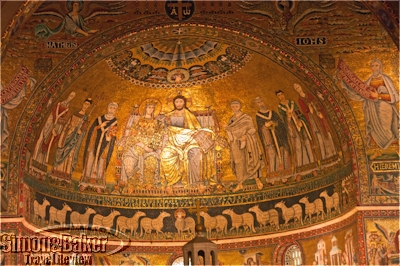
High altar Byzantine mosaic detail at Santa Maria Maggiore
In the lounge, a wall-size parchment map of an ancient perspective of the Mediterranean Sea was a reminder of the property’s name, as well as a nod to the Gallery of Maps at the Vatican. In the dining room, a stunning mosaic of a medieval hunt brought to mind the splendid tapestries of Renaissance palaces. Then there were the museum-worthy marble busts of Roman emperors interspersed throughout. I enjoyed walking through the majestic spaces and discovering new artistic details that had previously escaped my attention.
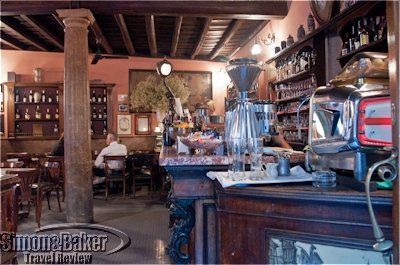
The Caffe della Pace
Although I discovered a new Rome favorite spot at the Mediterraneo, I didn’t neglect my old friends. I paid a neighborly visit to Santa Maria Maggiore. Built in the fifth century, this ancient Basilica still glows from the gold of byzantine mosaics that cover its triumphal arch and high altar. I headed to the Trevi Fountain for a quick nod of thanks. I couldn’t resist dropping by the Pantheon where for a few euros, tourists from around the world have their pictures taken with centurions in crimson capes and plastic armors. I stepped inside as well, to stand under the perfect rotunda and look up at the sky through its central oculus.
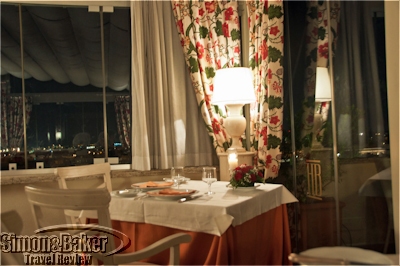
The Hotel Mediterraneo Roof Garden dining room at dinnertime
I went to Piazza Navona to take a fresh look at Bernini’s Fountain of the Four Rivers, which had been under wraps for repairs on two previous visits. Then I wandered into the old streets behind the Piazza, to the Caffe della Pace, a neighborhood favorite for over a century, in the street of that lent it its name, for a Spritz (popular local cocktail made of dry white wine, sparking water and bitter Aperol).
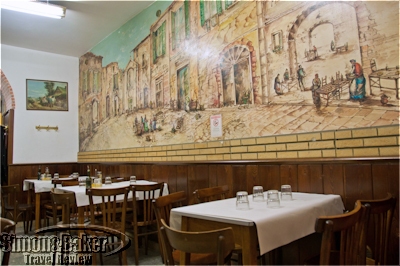
A favorite no-name fish eatery near Campo de Fiori
Thus reinvigorated I continued down the street to Santa Maria della Pace (Saint Mary of Peace) for a glimpse at the exquisite Raphael frescoes in the Chigi Chapel. I visited Campo de Fiori for the daily open market and the surrounding back streets where traditional artisans and avant-garde designers share the narrow storefronts and cobbled courtyards. And I stopped at a hole-in-the-wall fish place with paper tablecloths where market vendors drop in for a quick bite over high-decibel conversation, and neighborhood residents dash in for take-home fried fish. I don’t believe it has a name, but the fried calamari was out of this world.
by Editor | Jan 21, 2013 | Accomodations, New Articles, Restaurants
Article and photos by Josette King
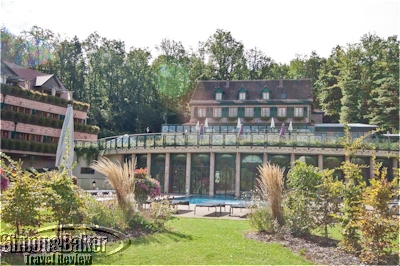
The property was located on three terraced levels
The Romantik Hotel and Spa les Violettes was the last stop on the itinerary of my recent visit to Alsace, France. I had spent a few days taking in the rich medieval art and architecture for which the area is renowned and enjoying its glorious wines and traditional cuisine (Paté de foie gras originated here in the 18th century). Les Violettes was just the right place to unwind before returning to Paris. Nestled in the densely forested foothills of the Vosges Mountains at the edge the Route des Vins (Alsace’s famed Wine Road), yet a mere 25 kilometers (16 miles) from Colmar, the property boasted superb spa facilities. In addition to three saunas with various heat and moisture levels, a steam room and whirlpool bath, there was an unusual halotherapy salt-cave and a grand counter-current indoor-outdoor pool that was a swimmer’s dream. The spa also had six private treatment rooms where it offered a range of massages, facials and body treatments.
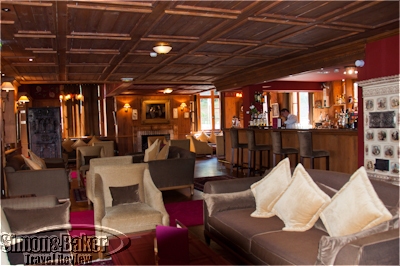
The Les Violettes bar sat in the corner of the open plan lounge
Then there was Le Jardin des Violettes, the property’s outstanding restaurant. In a region that has long held bragging rights for being home to an exceptional density of noted chefs and multi-award restaurants, Le Jardin des Violettes exceeded my expectations. The elegant dining room was decorated in warm shades of cinnabar and taupe that gave the formal space a cozy atmosphere. Subtle indirect lighting filled the room with a faint rosy glow that enhanced the formal table setting and provided just the right touch of romance to showcase the exciting creations of Chef Jérôme Jaeglé.
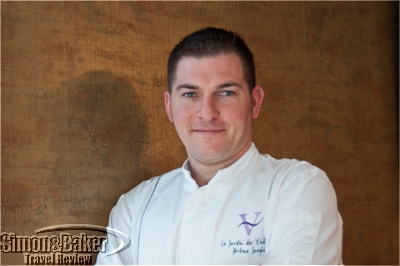
Chef Jerôme Jaeglé
Before taking over at Le Jardin des Violettes in early 2012, this talented young chef still in his early thirties, accumulated impressive credentials, including working as chef at Jean Yves Schilinger (a Colmar institution) and at Christian Têtedoie in Lyon. He found time to excel in some of the most respected French and international culinary competitions. A two-time winner of the National Taitinger Competition (in 2006 and 2008), recipient of a bronze medal in the Paul Bocuse European competition in 2010, he went on to take fourth place in the 2011 Bocuse Worldwide event. But through it all, this Colmar native maintained his passion for the bounty of the Alsatian countryside. During my visit, he explained that he lets the seasonable availability of locally sourced products guide his creativity. And he leads his team into foraging expeditions in the forests surrounding Les Violettes to gather the wild mushrooms and commercially unavailable greens that give his cuisine its unique cachet.
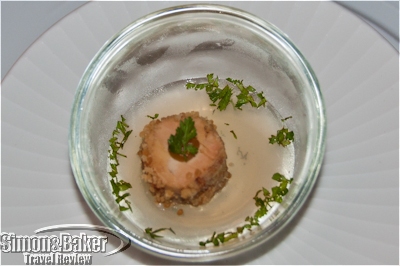
Foie gras on jellied green tea
I dined twice at Le Jardin des Violettes, and from amuse-bouche to dessert, each dish was an imaginative creation that delighted the eye and the palate. A light base of jellied green tea offset a rich nugget of paté de foie gras; chestnuts enhanced a wild mushroom duxelle, a simple mousseline of potatoes rose to the culinary stratosphere when whipped with walnut oil and garnished with oxalis (tiny wood sorrel leaves with a tangy, peppery taste). I can still taste a divine grilled filet of red snapper served with its skin deeply scored into julienne strips and caramelized crackling-style, while the tender white fish beneath was cooked to delicate perfection. And how could I forget his sublime cassolette (small casserole) filled with a fricassee of freshly gathered wild mushroom that concealed a farm-fresh egg softly poached in mushroom juices? Small wonder that Le Jardin des Violettes was awarded Two Toques from Gault et Millau in 2012.
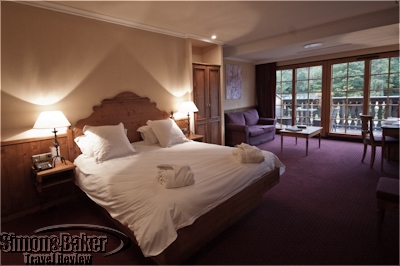
My room opened onto a large deck
The service was equally superb, unfailingly attentive yet unobtrusive. The extensive wine list included a wide selection of Alsatian wines as well as other wine-growing regions of France. From it, Alexandre Figenwald, the knowledgeable young sommelier, assisted us in selecting just the right bottles to enhance our meals (including a memorable Riesling Grand Cru Schlossberg 2010, Domaine Weinbach, Kayserberg). The one drawback of having experienced Chef Jaeglé’s cuisine is that it has become a personal benchmark against which most restaurants I have visited since Le Jardin des Violettes find it hard to measure up.
by Editor | Jan 7, 2013 | Accomodations, Attractions, New Articles
Article and photos by Josette King
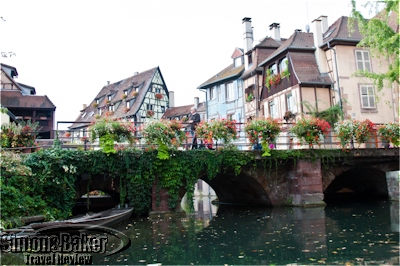
La Petite Venise was once home to tanners and fishmongers
Alsace, this strip of fertile plain stretched along the western bank of the Rhine River in the northeastern corner of France, is a region long on history and charm. The object of a millennium-long tug-of-war between France and Germany, it has successfully integrated elements of both cultures into a unique personality: decidedly French but with a noticeable German flavor in its architecture, arts, cuisine and traditions. And in spite of its troubled past, it has managed to preserve most of its cultural patrimony. Nowhere is that more evident than in Colmar, the medieval architecture gem in the heart of La Route des Vins, the much-visited hundred-mile country road that meanders north to south through the Alsatian vineyards.
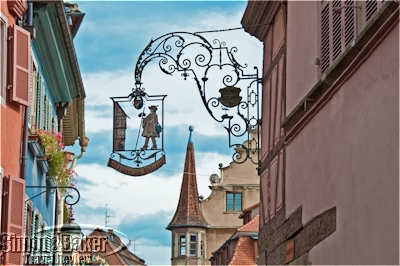
Antique wrought iron signs are still a common sight in Colmar
Mainly spared the destruction of the French revolution and two world wars, Colmar has an exceptionally large and well-preserved historic center for a city its size (population 65,000). I appreciated its laidback small town joviality and its easily walkable cobblestone streets lined with architectural treasures that span eight centuries of combined French and German evolution. At the edge of the historic town, the especially picturesque La Petite Venise (Little Venice) neighborhood is clustered around a network of canals from the River Lauch, where tanners and fishmongers quarters were once located. Farmers also used these waterways to ferry their products to the town market in small pole-propelled wooden barges. Similar barges are in operation today, with silent electric motors, to allow visitors a close look at the ancient (and still inhabited) riverside homes.
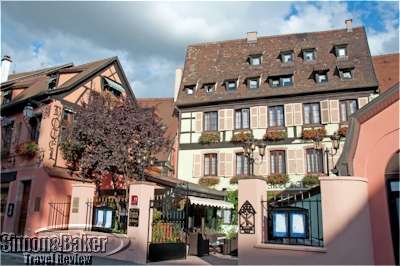
Romantik Hotel Le Maréchal opened onto a private courtyard
One of the finest historic properties of La Petite Venise is the picture perfect Romatink Hotel Le Maréchal. The luxury hotel was created from four adjoining 16th century half-timbered houses with their steep tiled roofs and neat rows of windows underlined with flower boxes overflowing with red geraniums. The rear of the hotel abuts the edge of the river, while the façade opens onto a small private courtyard. Inside, common walls have been opened and passageways link the various common areas with a maze of cozy nooks filled with antiques. An elevator is discretely tucked in a remote corner. My room, located under the eaves at the very top of the property, had slanted beamed ceilings and dormer windows that overlooked the roofs of the old town.
With its rustic Alsatian décor (discretely enhanced by 21st century amenities) it was a charming nest that beautifully captured the romance of the historic city. Equally appealing L’Echevin Restaurant occupied the entire rear of the first floor. There the space had been cleverly distributed to form a long, intimate dining room lined with picture windows that overlooked the river. It provided a worthy setting for the excellent cuisine of Chef Thierry Chefdeville, who has officiated in the kitchen for over a decade, earning such coveted recognitions as two toques from Gault et Millau and three forks from Michelin along the way, and firmly establishing L’Echevin’s standing as a noted destination for Alsatian gastronomy.
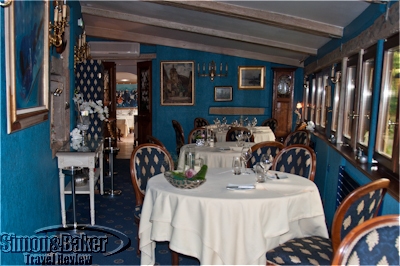
The restaurant, L’Echevin, overlooked the river Lauch
The pleasure of my stay at Le Maréchal, along with a couple of superb dinners at L’Echevin and the opportunity to wander at leisure around neighborhoods of meticulously maintained medieval houses would be reason enough for a weekend break in Colmar, especially now that several daily TGVs (Train à Grande Vitesse) have made it an easy three-hour and twenty minutes ride from Paris. But on this recent visit, there was also the lure of the town’s foremost artistic treasure: the Unterlinden Museum. Housed in a 13th century Dominican Sisters’ convent that is in itself a fine example of Gothic conventional architecture, the Unterlinden Museum holds a rich collection of Upper-Rhenish medieval and early renaissance sculptures and paintings.
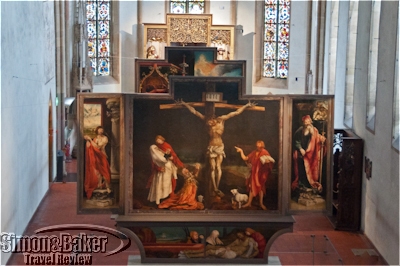
Matthias Grünewald’s masterpiece, the Isenheim Altarpiece is on display at the Unterlinden Museum
In addition to works by Lucas Cranach the Elder and Albrecht Dürer, it features several notable altarpieces by 15th century native son Martin Schongauer, and above all what is widely acknowledged as early 16th century master Matthias Grünewald’s greatest achievement: the Isenheim Altarpiece. Originally painted in 1512-1516 for the Monastery of Saint Anthony in Isenheim near Colmar, this unique oil on wood triptych has a center panel 2,70 meter (8 foot 10 inches) high by 3,10 meter (10 feet) wide depicting an especially poignant crucifixion scene. It was customary at the time for such triptychs to open to reveal additional scenes inside.
In the case of the Isenheim Altarpiece, there are actually two sets of wings, therefore two interiors. The first is a set of four panels depicting various scenes featuring the Virgin and Christ. The second interior is a carved shrine containing a polychrome sculpture of Saint Anthony flanked by Saints Augustine and Jerome, by sculptor Nicholas von Hagenau, with two more paintings (the Meeting of Saints Anthony and Paul, and the Torment of Saint Anthony) on the wings to the left and right respectively. In anticipation of its 500th anniversary, the masterpiece had been removed from view for restoration in recent years, and returned on display earlier this year.
by Editor | May 21, 2012 | Accomodations, Attractions, New Articles
Article and photos by Josette King
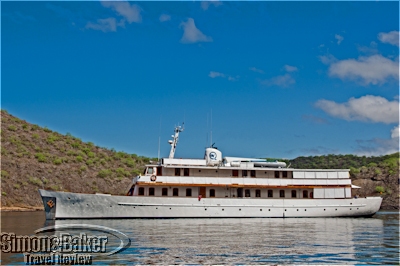
The M/Y Grace at anchor in a secluded cove of the Galapagos archipelago
After a 1,000-kilometer flight over empty Pacific Ocean waters, the AeroGal Airlines jet was preparing to land on San Cristobal, the easternmost island of the Galapagos Archipelago. The few returning locals were already gathering their belongings. Meanwhile, we the tourists were craning our necks to catch a first glimpse of the islands. The plane banked, revealing under its wing a zigzag of rocky coastline, punctuated by an occasional crescent of white sand; and no discernible sign of human life. Another turn unveiled a dazzling panorama of ancient volcanic peaks and dark rock formations emerging from an impossibly blue sea. All this natural splendor, and we hadn’t yet landed.
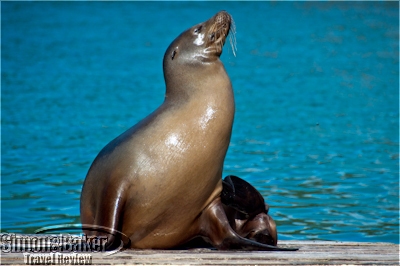
Galapagos sea lion
Once we did, I discovered another unique characteristic of the islands: the sense of undeniable entitlement of its wildlife. Even in the center of Puerto Baquerizo Moreno, the tiny provincial capital of the Galapagos adjacent to the airport, birds and reptiles and especially sea lions treated our presence with superb indifference. The later, enjoying their siesta sprawled on the boat dock, didn’t even twitch as I squeezed by to board the panga (local inflatable zodiac-type skiff) that was to take me to the Motor Yacht Grace.
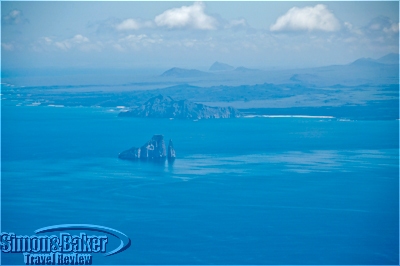
San Cristobal landing
My first glance at the elegant lines of this classic yacht was a special thrill. It brought back fantasies I had shared with an entire generation of French schoolgirls half a century before. Its owner was Prince Rainer III then, and it was named the Deo Juvante (Latin for with God’s help) after the motto of the house of Grimaldi, the rulers of the tiny French Riviera principality of Monaco for almost a millennium. For a few weeks in 1956, it had been front page news on French magazines and movies screens: the prince, sailing to meet the ocean liner USS Constitution to welcome his fiancee, the American movie star Grace Kelly; then the following week, Prince Rainer and the now Princess Grace boarding the yacht again for a seven-week honeymoon. Throughout the spring, there had been images of the yacht anchored in the most romantic destinations around the Mediterranean. Now this glamorous vessel was to be my home for a seven-night cruise around the Galapagos Archipelago, royal matrimony not required.
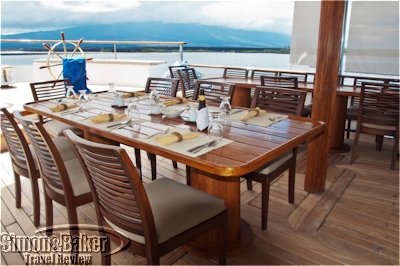
The shaded fresco dining area at the rear of the main deck
The yacht, renamed the M/Y Grace in homage to its most illustrious owner, is now the property of Quasar Galapagos Expeditions. Its owner Eduardo Diez, a man with a passion for classic yachts, oversaw a two-year, $2.5 million overhaul of the ship, while preserving its distinctive lines. The Grace, newly outfitted with a state-of-the-art stabilizer system to ensure smooth sailing on the open waters around the Galapagos islands, a large hot tub on the sundeck, modern bathrooms in each of its nine staterooms and air conditioning throughout, began operations in the spring of 2009. While I admit that it was the prospect of sailing on the Grace that propelled my desire to visit the Galapagos “some day” to the top of my travel wish list, the understated luxury of the vessel turned out to be merely the setting for a unique wilderness adventure. With only seven passengers and a crew of 10 on board, our naturalist guide, Rafael Pesantes Aguirre (Rafa for short) quipped that our odds for mutiny were unpromising.
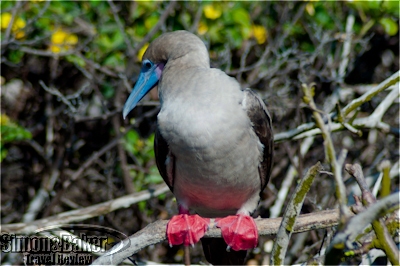
Red footed booby
But between the attentive pampering of the friendly staff and the exhilarating daily discoveries of the cruise, mutiny was the last thing on my mind. The exceptional itinerary took us to remote places rarely visited by larger ships. And Rafa, a third generation native of the islands and an ornithology graduate from San Francisco University in Quito, coupled an encyclopedic knowledge of the natural wonders of the area with the familiarity of one who has swum since childhood in the crystal clear waters of its most secluded coves. Our land excursions were filled with close encounters with some of rarest wildlife on the planet. We wandered on powdery white beaches shared only with colonies of sea lions and hiked along black lava rock paths to observe at close range the courtship ritual of Nazca boobies and waved albatross.
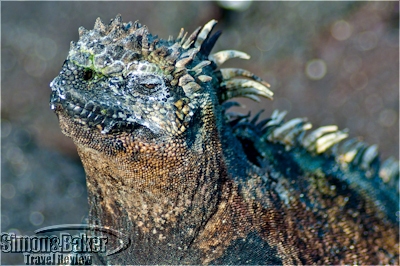
Fernandina marine iguana
We rode our panga along the edge of vertical cliffs dotted with blue-footed boobies and tiny Galapagos penguins, and watched frigate birds and brown pelicans nosedive for their breakfast. For me the highpoint of the day was invariably our snorkeling expedition. In island after island, Rafa led us to the most exotic marine life I have ever observed. I swan surrounded by so many giant sea turtles that it was a challenge to get out of their way. I observed a hammerhead shark, mercifully unconcerned by my presence; and I can now boast that I was personally pecked by a flightless cormorant! Visit the Simon & Baker Travel Review to read more about my Galapagos Archipelago cruise aboard the M/Y Grace.
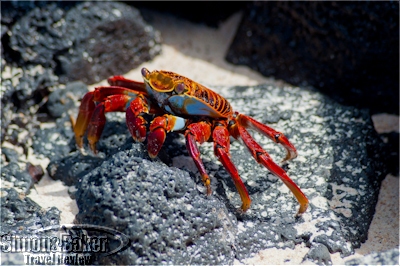
Sally Lightfoot crab
by Editor | Apr 23, 2012 | Accomodations, Attractions, Ecotourism, New Articles
Article and photos by Josette King

Hoatzin birds were a frequent sight near the lodge
“Stop, stop!” I sputter, too excited to keep my voice down. Fabian, the local park ranger who is paddling, doesn’t speak English but he gets the idea and brings the canoe to a smooth halt. Roberto, my Ecuadorian guide who speaks English fluently, looks at me askance. He has just pointed out a large bird perched in the dense jumble of rainforest. It looks like a chicken with too much turquoise eye shadow and a bad hair day. “The bird,” I exclaim. “Yes, it’s a hoatzin,” he reiterates matter-of-factly. He clearly fails to grasp the importance of the moment. So does the bird, which has by now been joined by two of its friends. They are engaged in a croaky argument while heartily tucking into the foliage. I feel compelled to explain that on a previous Amazon visit, a thousand miles downriver from here, I had once spent a whole week, including a half-day hike in the waterlogged underbrush, in search of a hoatzin. And I had only managed to hear its distinctive cry and ponderous take off as it vanished into the forest canopy. “We have lots of hoatzins here,” Roberto assures me after I have photographed these to my heart’s content, and for good measure a rare rufescent-tiger heron that has been observing the proceedings from a nearby stump.
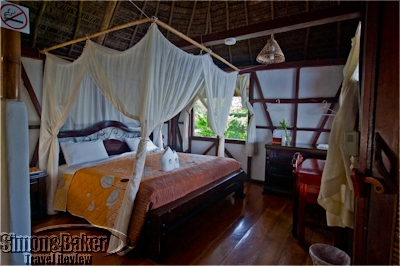
The king size bed was draped in mosquito netting
We resume our slow way upstream under an arch of tangled mangroves and palms, along the narrow channel that connects the Napo River, one of the most important tributaries of the Amazon, to Anangucocha Lake. We are in the heart of 21,400 hectares (82 square miles) of conservation land located on the ancestral territory of the Kichwa Anangu community, in the northwest corner of Ecuador’s Yasuni National Park. The park is a UNESCO Biosphere Reserve regarded by scientists as one of the most bio-diverse areas on the planet. Several notable sightings later, including a tree-toed sloth and my first ever monk saki monkey, we reach the lake. On its far side, the shore is dotted with the thatched-roofed, bright ocher adobe bungalows of the Napo Wildlife Center luxury eco-lodge.
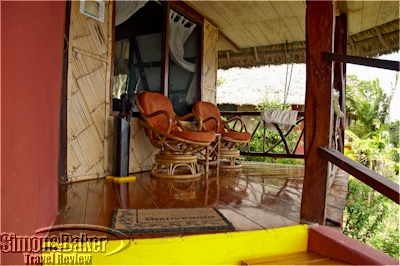
My bungalow had a shaded terrace overlooking the lake
Set into some of the most pristine rainforest environment I have ever visited, the lodge is designed to meet the high expectations of international tourists for wilderness accommodations. It features attractive bungalows with private terraces overlooking the lake, modern bathrooms, round the clock electricity and WiFi connection throughout the property. Strategically located observation towers at the lodge and in the forest offer a unique perspective of the abundant wildlife around the lake and above the forest canopy. My wildlife viewing is exceptional, not only for its abundance and variety but because of the excellence of the guiding. At the lodge, guides come in pairs: a bilingual, state-licensed guide and a native Yasuni Park-licensed ranger who also acts as a local guide, sharing his knowledge of plants, medicinal plants and Kichwa traditions. One evening, they take me on a nighttime canoe ride in the swamps near the lodge, with a special spotlight to view nocturnal creatures.
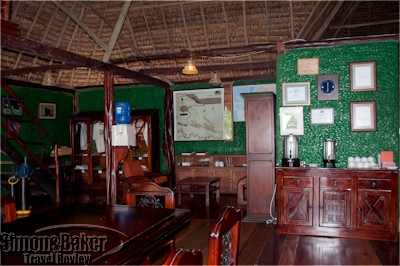
Coffee was served around the clock in the main hall
Beyond the excellence of accommodations and wildlife viewing opportunities, a highpoint of my visit is the opportunity to observe first hand the positive impact of the Napo Wildlife Center on the daily life of the Anangu people. The lodge and conservation land are wholly owned and managed by the Kichwa Anangu community. They are the keystones of a far-reaching program to improve the quality of life of the people and preserve the integrity of their ancestral territory and culture while providing them with sustainable employment. Most of the staff comes from the community. Their pride in the Napo Wildlife Center is palpable, and translates into warm and attentive service. Additionally, while the life of the community is separated from tourism activities, one hour downstream from the lodge, I see women welcome guests to the Interpretation Center facility adjacent to their village. It is especially rewarding to be able to connect with them (with Roberto as interpreter) as they introduce me to the tasks of their daily lives as well as their traditional Kichwa crafts and dances.
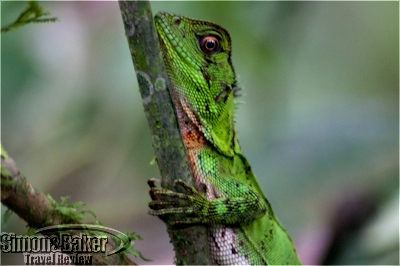
An Amazon forest dragon
I am gratified to hear of the rigorous sustainable tourism practices implemented by the Napo Wildlife Center program. Profits are reinvested within the community, with education and healthcare as major priorities. The center also returns a share of the annual profits to each family and provides a stipend to the elderly. To limit the lodge’s impact on its environment, it has implemented an environmentally sustainable sewage system, with waste waters treated to high standards before being released into the swamps. Trash is kept to a minimum and composted whenever possible. What is safe to burn is burned and buried, with the remainder transported to designated landfills outside the park. And these practices have been extended to the Anangu community at large, for a cleaner, healthier living environment.
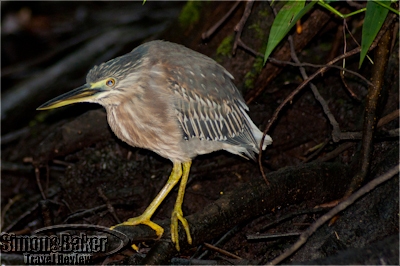
A striated heron
The Napo Wildlife Center is also engaged in a strong anti-poaching program, with its conservation land patrolled by community rangers employed and equipped by the lodge. The Napo Wildlife Center was recognized in 2009 with the Rainforest Alliance Community Sustainable Trend Setter Award, and the Best Jungle Lodge Award from the Latin American Travel Association at the World Travel Market in London, U.K. And it is becoming a model for other sustainable tourism community projects throughout Ecuador.
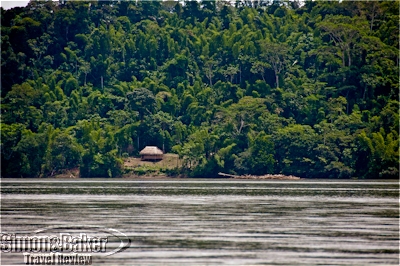
The banks of the Napo River were a tangle of dense rainforest
And by the way, Roberto was right. We came across so many hoatzins during my four-day visit that by the time I left, I barely spared them a glance. Visit the Simon & Baker Travel Review to read more about my stay at the Napo Wildlife Center.








































